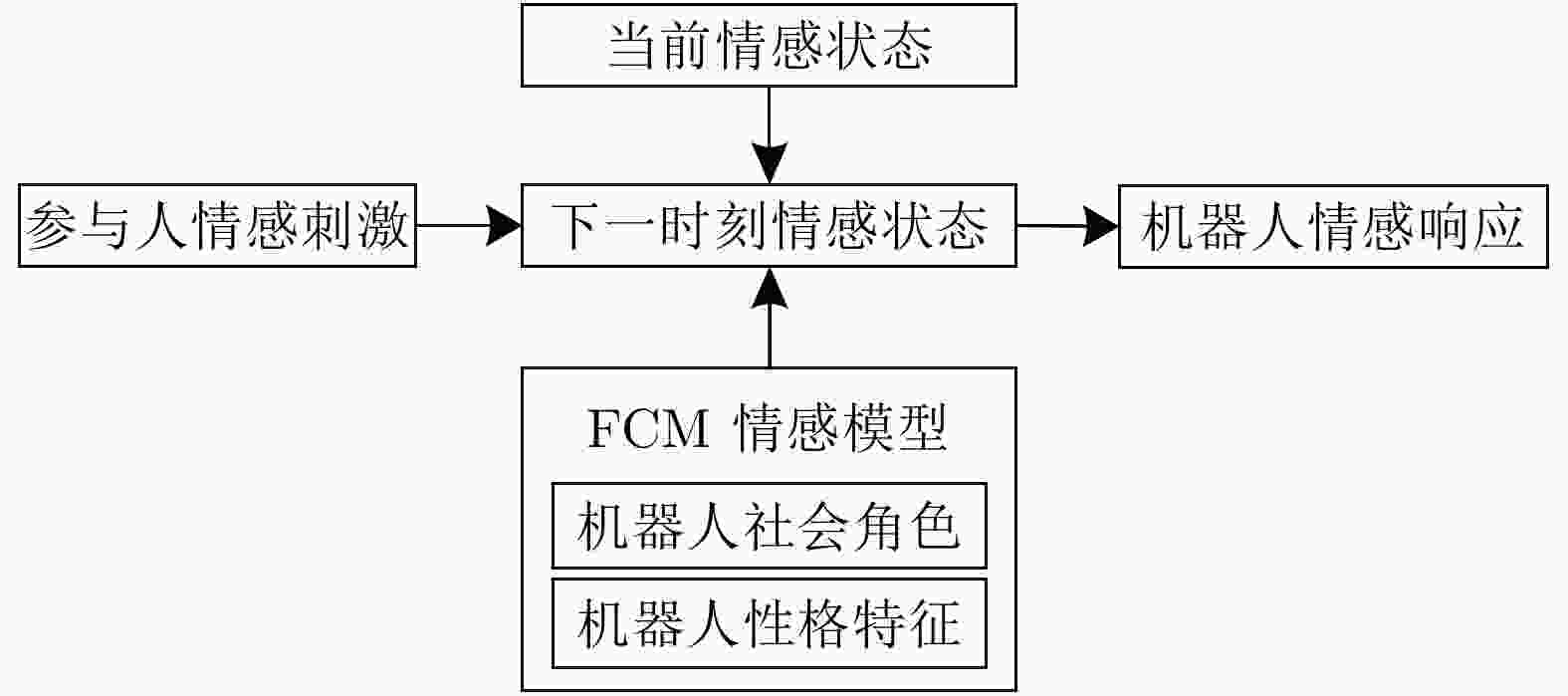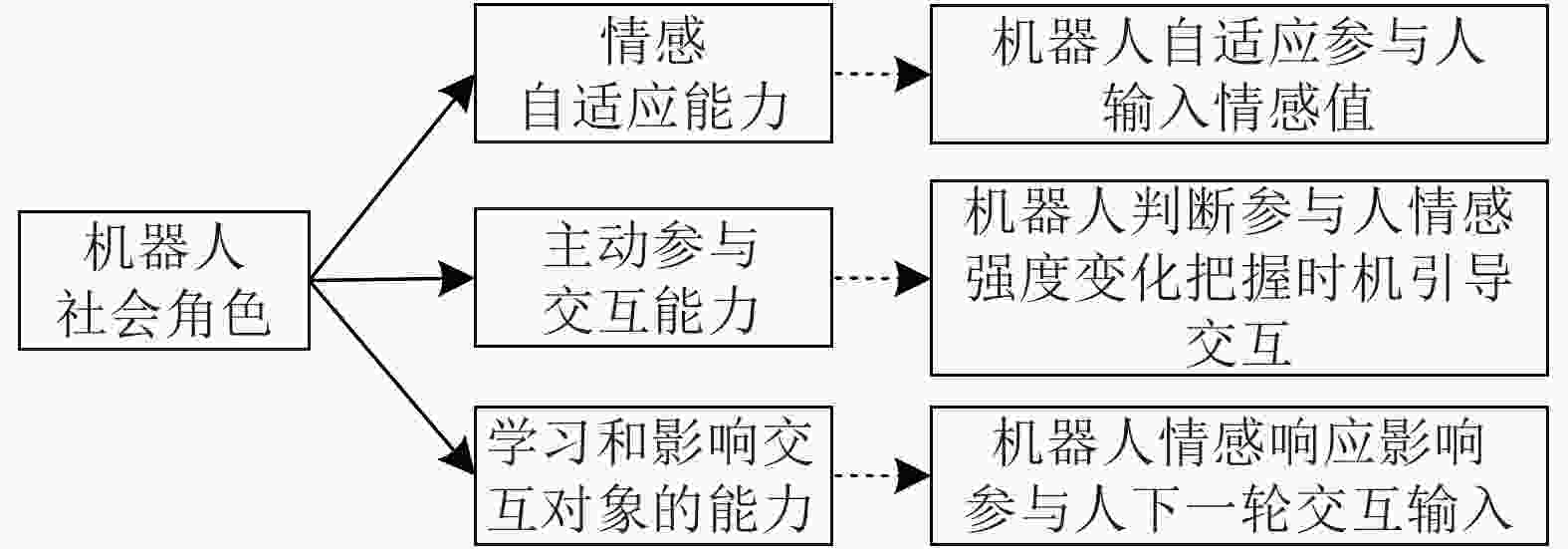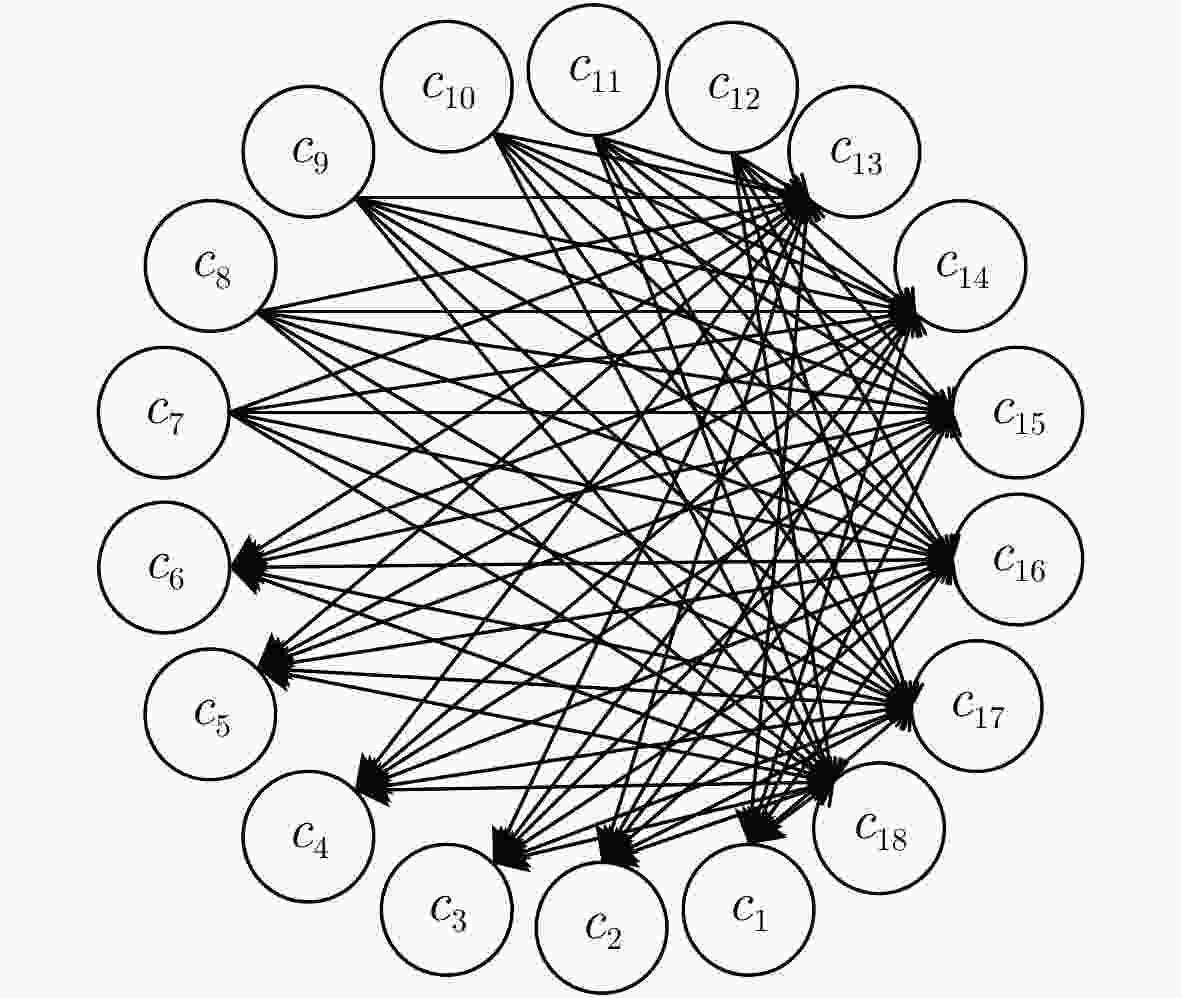Robot Emotion Response Model Based on Fuzzy Cognitive Map
-
摘要: 针对现有人机交互系统广泛存在机器人情感响应缺乏独特性和主动性、参与人参与度、满意度、体验感不高的问题,该文依据愉悦度-激活度-优势度(PAD)情感空间提出一种基于模糊认知图的机器人情感响应模型。首先,获取参与人交互输入情感值,对其评估得到参与人的情感状态矩阵;其次,考虑到机器人的性格特征和社会角色,利用模糊认知图的时间连续性,建立当前情感状态与上下文长期情感状态之间的关联,从而对机器人情感响应过程进行建模;最后,根据机器人的性格特征和社会角色对情感响应的影响,更新机器人的情感状态矩阵,并将其映射到连续情感空间中,得到机器人的情感响应。模型对比实验结果表明,该文所提模型能够增加机器人情感响应的主动性、独特性并且能够有效提升参与人的满意度,增加参与人体验感。
-
关键词:
- 机器人 /
- 人机交互 /
- 愉悦度-激活度-优势度情感空间 /
- 模糊认知图 /
- 情感响应
Abstract: In view of the existing human-computer interaction systems, which generally exist in the robot’s emotional response lack of uniqueness and initiative, and low participation degree, satisfaction degree and experience sense of participants, a model of emotional response of robots based on fuzzy cognitive map based on the emotional space of Pleasure-Arousal-Dominance (PAD) is proposed. Firstly, the participants’ interactive input emotion values are obtained, and the participants’ emotional state matrix is obtained by evaluating them. Secondly, considering the personality characteristics and social roles of the robot, the relationship between the current emotional state and the long-term emotional state of the context is established by using the time continuity of fuzzy cognitive map, so as to model the robot emotional response process. Finally, according to the influence of the robot’s personality and social role on the emotional response, the emotional state matrix of the robot is updated and mapped into the continuous emotional space to obtain the robot’s emotional response. The model comparison experiment results show that the proposed model can increase the initiative and uniqueness of the robot emotional response, and effectively improve the satisfaction of the participants, and increase the participants’ sense of experience. -
表 6 不同模型交互参与度结果
模型 N(轮) T(s) Chatterbot 5 54.36 GCRs 12 130.24 MECS 8 87.16 RL 11 119.63 ACO 7 75.61 本文 14 153.47 表 1 基于模糊认知图的机器人情感响应模型
输入:第k轮交互参与人交互输入情感值${{\boldsymbol{E}}_{\text{H}}}$,模糊认知图状态值3元序组$ M = (C,E,{\boldsymbol{W}}) $; 输出:第k轮机器人回复给参与人的情感响应值${\boldsymbol{E}}_{\text{R}}^{}$; Repeat: 参与人交互输入情感${{\boldsymbol{E}}_{\text{H}}}$; 根据式(1)—式(3)对${{\boldsymbol{E}}_{\text{H}}}$进行情感状态评估得到$ {\boldsymbol{I}}({{\boldsymbol{E}}_{\text{H}}}) $; 根据式(4)、式(5)计算参与人情感强度${\text{Intensity(}}{{\boldsymbol{E}}_{\text{H}}}{\text{)}}$的变化; 根据式(6)、式(7)计算当前情感状态下,机器人性格经过大五人格修正后的情感响应计算值${{\boldsymbol{e}}_c}$; 根据式(8)—式(12)训练FCM模型,对权重矩阵${\boldsymbol{W}}$进行更新获得机器人在6种基本情感上的情感强度; 根据式(13)对机器人在6种基本情感上的情感强度进行PAD情感空间坐标标定,得到机器人的情感响应; Until 停止输入交互情感; 人机交互结束 表 2 不同模型交互体验感结果
模型 连贯性(单轮) 合理性(单轮) 多样性(单轮) 流畅性(多轮) 一致性(多轮) 准确性(多轮) GCRs 1.478 1.319 1.184 1.129 1.326 1.147 MECS 1.279 1.437 1.247 1.396 1.284 1.056 RL 1.496 1.124 1.345 1.238 1.096 1.342 ACO 1.351 1.386 1.239 1.327 1.312 1.258 本文 1.532 1.497 1.412 1.506 1.468 1.523 表 3 交互体验感消融实验
交互体验感消融实验 连贯性(单轮) 合理性(单轮) 多样性(单轮) 流畅性(多轮) 一致性(多轮) 准确性(多轮) FCM+性格特征 1.425 1.419 1.432 1.474 1.429 1.465 FCM+社会角色 1.467 1.438 1.384 1.486 1.447 1.496 两个因素都有 1.532 1.497 1.412 1.506 1.468 1.523 表 4 不同模型交互满意度结果
模型 情感相似度 情感精确度 情感活跃度 交互满意度 GCRs 0.615 0.695 0.536 0.631 MECS 0.637 0.768 0.462 0.654 RL 0.642 0.729 0.471 0.642 ACO 0.568 0.637 0.436 0.569 本文 0.671 0.794 0.517 0.689 表 5 交互满意度消融实验
满意度消融实验 情感相似度 情感精确度 情感活跃度 交互满意度 FCM+性格特征 0.557 0.636 0.509 0.579 FCM+社会角色 0.648 0.732 0.498 0.651 两个因素都有 0.671 0.794 0.517 0.689 表 7 交互参与度消融实验
参与度消融实验 N(轮) T(s) FCM+性格特征 12 126.35 FCM+社会角色 12 132.56 两个因素都有 14 153.47 表 8 不同模型有效性评价结果
模型 MRR MAP Chatterbot 0.457 0.485 GCRs 0.624 0.643 MECS 0.591 0.612 RL 0.587 0.604 ACO 0.482 0.503 本文 0.653 0.674 表 9 有效性消融实验
有效性消融实验 MRR MAP FCM+性格特征 0.569 0.592 FCM+社会角色 0.624 0.637 两个因素都有 0.653 0.674 -
[1] TAO Jianhua and TAN Tieniu. Affective computing: A review[C]. First International Conference on Affective Computing and Intelligent Interaction, Beijing, China, 2005: 981–995. doi: 10.1007/11573548_125. [2] ZHAO Zhi and HUANG Jinde. Emotion computing method based on knowledge representation[C]. 2020 International Conference on Computer Engineering and Application (ICCEA), Guangzhou, China, 2020: 368–372. doi: 10.1109/ICCEA50009.2020.00086. [3] 韩晶, 解仑, 刘欣, 等. 基于Gross认知重评的机器人认知情感交互模型[J]. 东南大学学报:自然科学版, 2015, 45(2): 270–274. doi: 10.3969/j.issn.1001-0505.2015.02.014HAN Jing, XIE Lun, LIU Xin, et al. Cognitive emotion interaction model of robot based on Gross cognitive reappraisal[J]. Journal of Southeast University:Natural Science Edition, 2015, 45(2): 270–274. doi: 10.3969/j.issn.1001-0505.2015.02.014 [4] PARK S H, BAE B C, and CHEONG Y G. Emotion recognition from text stories using an emotion embedding model[C]. 2020 IEEE International Conference on Big Data and Smart Computing (BigComp), Busan, Korea (South), 2020: 579–583,doi: 10.1109/BigComp48618.2020.00014. [5] 孙晓, 彭晓琪, 胡敏, 等. 基于多维扩展特征与深度学习的微博短文本情感分析[J]. 电子与信息学报, 2017, 39(9): 2048–2055. doi: 10.11999/JEIT160975SUN Xiao, PENG Xiaoqi, HU Min, et al. Extended multi-modality features and deep learning based microblog short text sentiment analysis[J]. Journal of Electronics &Information Technology, 2017, 39(9): 2048–2055. doi: 10.11999/JEIT160975 [6] 黄程韦, 赵艳, 金赟, 等. 实用语音情感的特征分析与识别的研究[J]. 电子与信息学报, 2011, 33(1): 112–116. doi: 10.3724/SP.J.1146.2009.00886HUANG Chengwei, ZHAO Yan, JIN Yun, et al. A study on feature analysis and recognition of practical speech emotion[J]. Journal of Electronics &Information Technology, 2011, 33(1): 112–116. doi: 10.3724/SP.J.1146.2009.00886 [7] 丁永刚, 李石君, 付星, 等. 面向时序感知的多类别商品方面情感分析推荐模型[J]. 电子与信息学报, 2018, 40(6): 1453–1460. doi: 10.11999/JEIT170938DING Yonggang, LI Shijun, FU Xing, et al. Temporal-aware multi-category products recommendation model based on aspect-level sentiment analysis[J]. Journal of Electronics &Information Technology, 2018, 40(6): 1453–1460. doi: 10.11999/JEIT170938 [8] 张国丽, 李祚泳. 基于蚁群算法的情感模型研究[J]. 计算机应用, 2009, 29(10): 2758–2761. doi: 10.3724/SP.J.1087.2009.02758ZHANG Guoli and LI Zuoyong. Emotional model based on ant colony algorithm[J]. Journal of Computer Applications, 2009, 29(10): 2758–2761. doi: 10.3724/SP.J.1087.2009.02758 [9] ZHANG Rui, WANG Zhenyu, and MAI Dongcheng. Building emotional conversation systems using multi-task Seq2Seq learning[C]. 6th CCF International Conference on Natural Language Processing and Chinese Computing, Dalian, China, 2018: 612–621. doi: 10.1007/978-3-319-73618-1_51. [10] FIRDAUS M, CHAUHAN H, EKBAL A, et al. EmoSen: Generating sentiment and emotion controlled responses in a multimodal dialogue system[J]. IEEE Transactions on Affective Computing, To be published. doi: 10.1109/TAFFC.2020.3015491. [11] SUN Xiao, LI Jia, WEI Xing, et al. Emotional editing constraint conversation content generation based on reinforcement learning[J]. Information Fusion, 2020, 56: 70–80. doi: 10.1016/j.inffus.2019.10.007 [12] RUSSELL J A and MEHRABIAN A. Evidence for a three-factor theory of emotions[J]. Journal of Research in Personality, 1977, 11(3): 273–294. doi: 10.1016/0092-6566(77)90037-X [13] PARK J W, KIM W H, LEE W H, et al. How to completely use the PAD space for socially interactive robots[C]. 2011 IEEE International Conference on Robotics and Biomimetics, Karon Beach, Thailand, 2011: 3005–3010. doi: 10.1109/ROBIO.2011.6181762. [14] 陶雪琼. 人工智能时代人机社会性交互设计研究[D]. [硕士论文], 江南大学, 2020. doi: 10.27169/d.cnki.gwqgu.2020.000441.TAO Xueqiong. Research on human-computer social interaction design in the age of artificial intelligence[D]. [Master dissertation], Jiangnan University, 2020. doi: 10.27169/d.cnki.gwqgu.2020.000441. [15] 孟琦. 基于情感词强度极值的情感嵌入模型研究[D]. [硕士论文], 哈尔滨工程大学, 2019.MENG Qi. Research on sentiment embedding model based on the value of sentimental word intensity[D]. [Master dissertation], Harbin Institute of Technology, 2019. [16] GOLDBERG L R. An alternative "description of personality": The Big-Five factor structure[J]. Journal of Personality and Social Psychology, 1990, 59(6): 1216–1229. doi: 10.1037/0022-3514.59.6.1216 [17] MEHRABIAN A. Analysis of the big-five personality factors in terms of the PAD temperament model[J]. Australian Journal of Psychology, 1996, 48(2): 86–92. doi: 10.1080/00049539608259510 [18] PAPAGEORGIOU E I, STYLIOS C D, and GROUMPOS P P. Active Hebbian learning algorithm to train fuzzy cognitive maps[J]. International Journal of Approximate Reasoning, 2004, 37(3): 219–249. doi: 10.1016/j.ijar.2004.01.001 [19] 田智行, 陈夏铭, 姜大志. 一种离散状态与维度空间互映射的人工情感模型[J]. 系统仿真学报, 2021, 33(5): 1062–1069. doi: 10.16182/j.issn1004731x.joss.20-0007TIAN Zhihang, CHEN Xiaming, and JIANG Dazhi. An artificial emotion model for the mutual mapping between discrete state and dimensional space[J]. Journal of System Simulation, 2021, 33(5): 1062–1069. doi: 10.16182/j.issn1004731x.joss.20-0007 [20] GUNTHER C. ChatterBot tutorial[EB/OL]. https://chatterbot.readthedocs.io/en/stable/tutorial.html, 2021. [21] China Computer Federation. The 6th conference on natural language processing and Chinese computing Dalian[EB/OL]. http://tcci.ccf.org.cn/conference/2017/taskdata.php, 2017. [22] WU Yu, WU Wei, XING Chen, et al. Sequential matching network: A new architecture for multi-turn response selection in retrieval-based chatbots[C]. The 55th Annual Meeting of the Association for Computational Linguistics, Vancouver, Canada, 2017: 496–505. doi: 10.18653/v1/P17-1046. -






 下载:
下载:






 下载:
下载:
